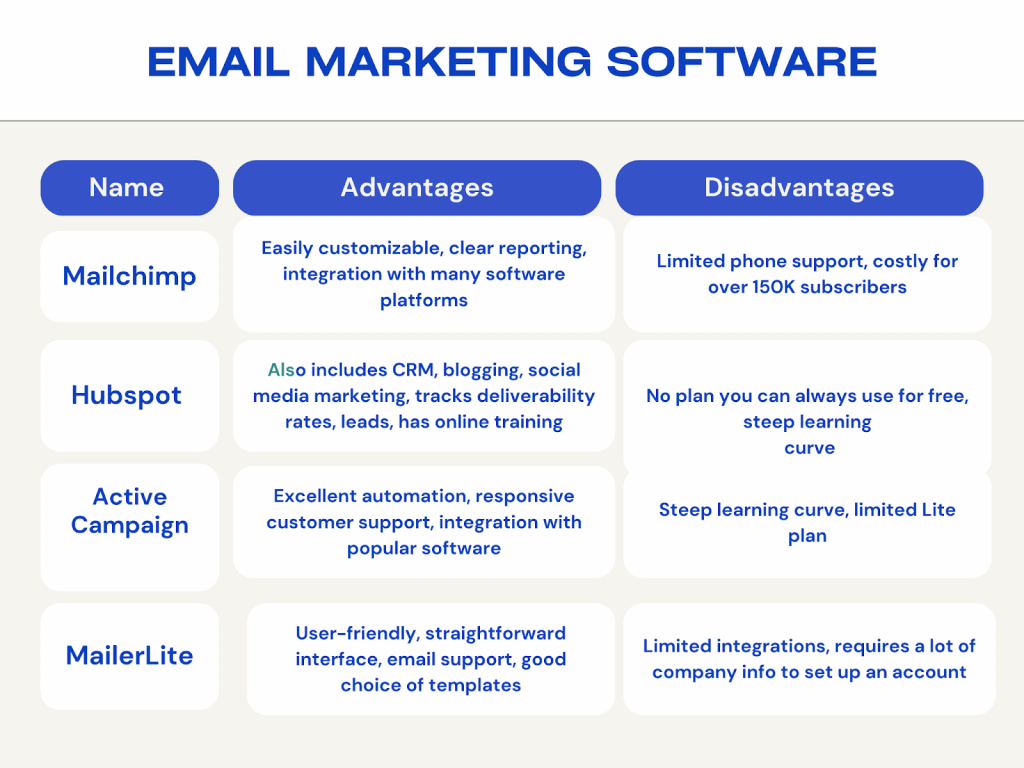All financial advisors are well aware of the fact that building strong relationships with your clients is crucial for success. While phone calls and in-person meetings are effective, they can also be time-consuming. That’s why email marketing is a powerful tool for any financial advisor looking to grow their business.
But handling email marketing can be daunting, especially if you’re a beginner. It’s just like making a cake for the first time. What are the right ingredients? In what order should you add them? How long does it take to bake it? How to serve it right so that your guests can savor it? You need step-by-step instructions to walk you through this process. That’s why we’ve put together a guide for you containing a list of major email marketing tips for making perfect email campaigns that will entice your audience and drive results.
Contents:
1. What is email marketing for financial advisors?
2. Examples of successful email marketing campaigns for financial institutions
3. Does email marketing work for financial advisors?
4. What is the best way to start email marketing for financial advisors?
5. Best email marketing service for financial advisors
6. What’s next? Monitor and track your email performance
What is email marketing for financial advisors?
Email marketing for financial advisors is a powerful tool that allows them to reach out to their clients and prospects in a streamlined and personalized way. It involves sending targeted, relevant, and engaging messages to a list of email subscribers, with the goal of driving engagement, building relationships, and ultimately, generating leads and revenue. For financial advisors, email marketing is a cost-effective and efficient way to keep their audience informed about the latest financial news and trends, share their expertise, and promote their services and products. Taking into account some features of email marketing campaigns specific to the financial industry that are listed below, financial advisors can stay top-of-mind with their existing and potential clients.
Financial advisors have to adhere to rigorous regulatory guidelines, including SEC, FINRA, or state securities regulations. As a result, it’s crucial to be very careful when creating and evaluating email marketing campaigns for financial advisors to guarantee conformity with these guidelines.
Trust and credibility are cornerstones of the financial sector as financial advisors deal with money matters. And email marketing campaigns can foster trustworthy and credible relationships with the audience by providing personalized and professional content that offers valuable insights to the recipients.
Financial advisors usually deal with some specific groups of people, like e-commerce clients, retired people, or millennials. To effectively reach out to these groups through email marketing, it’s necessary to craft a special message that addresses their particular needs and concerns.
It’s very important for financial advisors to strike a happy medium between sending too few emails and bombarding their clients with newsletters and updates. And they also need to be well aware of the appropriate timing of emails, particularly when it comes to investment or market insights.
Examples of successful email marketing campaigns for financial institutions
For you to get a clearer picture of what email marketing strategy entails, we’ll give a few instances of email marketing campaigns.
Wells Fargo
Wells Fargo’s recent email campaign seeks to encourage people who haven’t yet adopted the technology of depositing checks with their smartphones. The campaign is aimed at emphasizing its ease and convenience: Depositing a check is as easy as snapping a photo. It’s also depicted in the accompanying lifestyle photo and reinforced through bullet points. This is a good real–life example of promoting a widely available service to middle-age or older adults who use it but may find it difficult to switch to this method. The email’s CTA button encourages readers to sign on and transfers them to their account to try it now.
Toyota Financial Services
TFS decided to go with a two-email marketing campaign to inform their users about the possibility to participate in the yearly Giving Tuesday, an event which takes place after Black Friday: It’s time to give back to the charity of your choice. They allocated $150,000 to donate to four charities dividing the money based on the number of clicks each charity received. This initiative not only allowed TFS to participate in charitable giving but also encouraged their users to do the same. The follow-up email effectively highlighted the impact of this charity program and motivated customers to continue donating.
Acorn
Acorns is a financial service that invests the change left from your purchases into investment funds. In other words, it generates returns on investments. Acorns has created an email marketing campaign that links the concept of investment with the summer travel season. Users can receive a small investment into their accounts alongside with realizing their travel plans through the companies mentioned in a series of pictures in the email (Expedia, HotelTonight, Airbnb, and Zipcar), showing how much return they may get to their Acorns accounts, which looks highly motivating for the readers and encourages them to use the service while on vacation.
All in all, the key takeaway here is that your email campaign, or an email blast should first of all be driven by the interests, values and necessities of your target audience, be educative, concise, highly engaging, include illustrative imagery, and take into account their social characteristics. Keep reading to learn how to achieve this.
Does email marketing work for financial advisors?
Establishing relationships is of vital importance to the financial services industry. And email marketing is an effective tool for developing and nurturing those relationships. Since the rise of the internet, email has become one of the preferred forms of online communication. Email marketing is a cost-effective, user-friendly, and fast way to reach a large audience and solicit responses in a matter of minutes. According to the Direct Marketing Association, email marketing yields a return of an astounding 4,000% To be more precise, companies can potentially earn $36 to $45 on every dollar spent on marketing.
Email marketing is an excellent method for financial advisors to generate referrals by providing engaging content that resonates with their clients. For instance, email newsletters can contain updates on market trends and financial news. Personalized, automated emails can notify clients of your portfolio updates or upcoming events or appointments. In addition, drip campaigns – sending a series of automated emails to people who take a specific action on your website, can establish a relationship with potential clients until they are ready to schedule a consultation.
What is the best way to start email marketing for financial advisors?
Financial advisors often use email marketing to generate leads, but how can one ensure they run a successful email campaign? Financial advisor email marketing should rely on best practices and follow a number of crucial steps to win clients’ minds and hearts.
Step #1. Define strategy
The email marketing strategy involves a set of techniques that aid you in reaching the target audience with suitable content. This approach implies identifying users’ preferences, and delivering compelling content. Your email marketing strategy should be carefully pre-planned, and if you stick to the definite roadmap, you’ll be able to reach your goals in a very short time.
Generally, email marketing has two major types: inbound and outbound. The former is directed towards individuals who are already part of your email list, i.e. people who have shown an interest in your services by signing up or making an appointment. The latter targets prospects and introduces your brand with a view to attract new clients. In other words, it’s all about researching your target audience, conveying and delivering the right message for them to convert.
There are four main components of an email marketing strategy: problems, research and raw data, solutions, and a roadmap. For financial advisors, it’s important to conduct research of their target audience, consider their clients’ financial goals and life events to ensure that they remain engaged, identify the appropriate type of email marketing (newsletter, follow-ups, re-engagement emails, update emails, etc.), and use value propositions and lead magnets to keep subscribers interested.
When dealing with email marketing, it’s vital to understand how to target users at different stages of their journey. For instance, informational newsletters and guides are sent to new subscribers to increase awareness. And you should change the tactics as users move through the funnel. This way you reduce the risk of spam complaints, enhance email deliverability, and increase click-through rates (CTR). And if you stick to the roadmap based on thorough research, you’ll likely achieve a high return on investment (ROI) for marketing campaigns.
To track the success of your email marketing campaign, you might use a free and straightforward tool like Google Analytics, which provides detailed reports for both email and website traffic, or its alternatives.
Step#2. Collect contacts
There are many ways to put together contact lists for your email marketing campaign. While many of the tips are suitable for representatives of any profession, there are still some industry specific ones that can boost financial advisors’ contact lists.
Incorporate a lead capture into your website
Just like any professional nowadays, a financial advisor should have consistent social media presence, which can help their businesses in various ways such as promoting special offers, building brand awareness, and engaging with clients. So it’s recommended to have a lead capture form on financial advisor websites which offers something valuable such as a video, newsletter, or a free webinar in exchange for contact information.
Leverage influencer marketing
This tip is directly related to putting together a client base in the financial industry. It might be a good idea for financial advisors to cooperate with accountants and attorneys that naturally deal with their target audience – retirees, pre-retirees, mid-career professionals or well-off people. You could advertise on their website or contribute a post to their blog with a link leading to your website or social media page. It ‘s especially relevant for novices as it takes time to build a strong network.
Get involved in the life of the community
This is another good chance for financial advisors to expand their contact list. Actively participating in community activities that are so important for your target audience, and showing your prospects that you share their interests and values may eventually lead to business opportunities.
Host online talks or webinars
These will allow financial advisors to share their expertise and showcase their skills to a large audience of potential clients turning them into demanded professionals. Financial advisors can establish themselves as financial experts conducting an online webinar on financial literacy like how to be budget-friendly, telling your audience about the significance of financial planning. This way you boost your brand awareness and gain more contacts.
Reach out to prospects via social media
Digital marketing nowadays is impossible without social media marketing. You can leverage social media channels like Facebook, Twitter or Linkedin to expand your email marketing list. By encouraging your social media followers to subscribe to your email list, you can target an audience that’s already interested in your business. For example, you could obtain email addresses from Facebook by connecting your email software with this site, which will allow visitors to your Facebook page to easily sign up for email updates. Alternatively, you can use a Linkedin email finder to collect the contact information of your potential prospects from Linkedin and reach them out through personalized emails.
Pin a tweet on top of your social media page encouraging sign-up for emails
Besides integrating your email software, you can increase the chances of increasing your email list by showcasing the opportunities of subscribing to your email updates. You might want to share your latest newsletter, which will give readers an idea of what they’re going to get. It’s also a good idea to use quotes, unique data or other valuable information promoting your company, upcoming webinars and events. But make sure your tweets are short and concise. Another option is to use visuals, like an image or GIF, which will make your tweet more engaging.
Take advantage of social advertising
By utilizing ad formats on platforms like LinkedIn and Facebook that are designed for email signups, you can attract more potential customers.
It’s worth noting that your contact list should be permission based. It’s not recommended to purchase a contact list or send out newsletters without obtaining permission from the recipients.
Step#3. Content creation
We’ve already mentioned above that it’s crucial for marketing emails to be written in a clear and concise manner, provide a vivid picture of your services and highlight potential benefits to clients. Here’s a list of practical tips financial advisors might find useful.
Segment your list of contacts and personalize your emails.
Make sure you don’t fall into the trap of creating non-personalized content – the one that doesn’t take into account your clients’ individual characteristics or user behavior. To personalize emails, it’s essential to divide the email list into segments and create separate funnels for each segment of your clients or prospects based on their financial situation and demographics. The key is to customize the content of each email to cater to their specific concerns. To achieve this, consider a CRM solution to help you with the data.
Experiment with different elements such as different types of visuals or infographics, make extensive use of A/B testing, that is testing different parts of emails (subject lines, pre-headers, bodies, etc.) separately for different groups of recipients. As a result, you’ll be able to determine what resonates with each segment of your audience, which can lead to improved engagement and higher open rates.
Include a clear CTA
It’s common knowledge that any email marketing campaign should have clear call-to-action pushing the recipient to do what you need them to do. When crafting emails for your subscribers, it’s important to consider the desired action and outcome. The call-to-action section should contain an attractive incentive or offer, especially when email marketing is linked to financial planning or investing services. For financial advisors, such CTAs can ask the audience to arrange consultations, subscribe to newsletters and updates,or read a financial report. By creating content that is valuable and relevant to your audience, the call-to-actions will naturally result in conversions.
Include the possibility to opt out
Having no unsubscribe option is a pitfall you should take care to avoid. It’s extremely important to give people a chance to opt out from the email subscription, even though you might feel unwilling to lose a subscriber. There may be individuals who only signed up just for a lead magnet, and you should accept and respect that. Therefore, including an opt-out option in all of your emails is strongly recommended.
Best email marketing service for financial advisors
Automation of email marketing nowadays is paramount. It’s just as important as defining the strategy of the campaign. There are a lot of good offers on the market of email marketing software that promise impressive results, high ROI and open rates. The features that most email marketing software offer their users are typical: management of lists and segmentation, pre-designed templates, segmentation and personalization, tracking tools and analytics, lead collection tools, and some more. Hence, when choosing the right software for your company, you should be guided more by the size of your business and contact list and the number of emails you need to send a day or a month, rather than by your business sphere.
Here’s a selection of four email marketing software solutions that offer a variety of useful features.
Mailchimp
Mailchimp is a widely used email service known for its user-friendly interface. The platform offers a straightforward email builder and a range of Mailchimp templates financial advisors can use to quickly create appealing campaigns. It also features signup forms and landing page templates to help grow your target audience. Mailchimp’s advanced features include A/B testing, list segmentation, send time optimization, personalization of email content and even an e-commerce plugin to make product recommendations.
Mailchimp paid plans vary according to the number of subscribers on your contact list starting with $13 for 500 contacts. Their free plan is based on up to 500 contacts and 2,000 emails, though it doesn’t provide customer support or advanced analytics options.
Hubspot
Financial advisors with bigger audiences might also want to use Hubspot, an advanced software tool that provides email marketing capabilities through its Marketing, Sales and Service Hubs. The Marketing Hub targets to enhance traffic and lead generation, including emails, landing pages, social media ads, live chat, video, SEO, and content creation, while the Sales Hub offers email tracking and scheduling, meeting scheduling, CRM, predictive lead scoring, sales automation, email sequences, and reporting. And the Service Hub is all about support features.
The free plan allows storing up to 1,000,000 contacts. The cost of the paid plans starts at $30 per month.
ActiveCampaign
ActiveCampaign is another comprehensive solution for email marketing services that might benefit financial advisors as it enables its users to personalize emails using and conduct A/B testing to determine the best-performing content. Plus, it has a built-in spam tester. It also allows segmenting the audience based on email activity and track website visits and actions.
All plans here come with email and live chat support, and the prices begin at $29 per month for email support, inline form and tracking. But if you want more advanced automation features such as contact scoring or workflow A/B testing, get ready to upgrade.
MailerLite
The email marketing software MailerLite might be greatly appreciated by busy financial advisors who have no time for training to use sophisticated software. MailerLite stands out as one of the most user-friendly ones due to its drag-and-drop interface, which makes the process of crafting emails a breeze. The software has developed a highly efficient and easy-to-use platform, making it the top choice for users who seek convenience. In case of any issues, users can avail of email support to troubleshoot any arising problems.
The platform provides a free plan that allows users to have 1,000 subscribers while the paid plans begin at $9 per month.
Let’s see how these services compare:

Moosend
If you’re looking for a user-friendly tool with a short learning curve, you might want to
look into Moosend. The platform is ideal for financial advisors who want to build trust
and maintain relationships with their clients.
Moosend’s drag-and-drop email editor and ready-made templates make creating
professional-looking email newsletters easy and intuitive. At the same time, the platform
offers automation solutions that can help you streamline repetitive tasks like follow-ups
or email workflows.
Lastly, the platform offers real-time analytics and reports to track engagement and make
data-backed decisions that optimize your campaigns.
Moosend’s paid plans start at $9 per month for up to 500 subscribers and include key
features like full access to Moosend’s extensive template library. The tool also offers a
free 30-day trial with access to all core features, so that you can test the platform before
committing.
What’s next? Monitor and track your email performance
To achieve success with email marketing, it’s critical to get actionable insights into your email strategies. There are a number of key email marketing metrics you should keep a close eye on that measure how effective your marketing success is. They typically include open rates (aka open-click rates), click-through rates, conversion rates, and return on investment. These metrics help you identify what’s working and what needs improvement in terms of subject lines, audience engagement, CTA buttons, content relevance, and overall interest and influence of your emails. Your email campaign is considered satisfactory as long as these metrics equal or exceed the following: open rate – 20-30%, click-through rate – 2-5%, conversion rate – 10-20%, and ROI, as mentioned above, – 4000%.
It’s vital to ensure that accurate tracking is implemented for both email newsletters and website activity. This way, you’ll be able to identify the most and the least successful content and make informed decisions to improve your email marketing strategy, leading to an increase in subscribers.
Bottom line
In today’s world, email marketing is an inseparable part of running any business, the financial industry being no exception. An email campaign has numerous advantages as it’s a powerful, yet easy and cost-effective tool for financial advisors to achieve impressive marketing results like attracting prospects and converting them, engaging the current clients, increasing the client base, and driving more revenue.
A successful email marketing campaign should contain some essential ingredients: choosing an appropriate email marketing strategy, collecting contacts, segmenting and personalizing emails, creating clear, concise and valuable content with a compelling call-to-action section, using a variety of email types such as newsletters, follow-ups, update emails, etc., automating and tracking the process. Treat each of those ingredients with care, thoughtfully add and mix them, and your email marketing campaign will turn into an enticing dish your clients will want to indulge in.







.png)

I read an article on your website and I am very impressed by your blog.
This article is very informative and useful. It explains what email marketing is, why it is important, and how to do it effectively. I learned that email marketing is a form of digital marketing that uses email to communicate with potential and existing customers.
Thank you! We’re glad you found our material helpful.
Effective strategies for email marketing in financial advising!